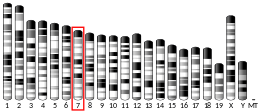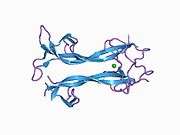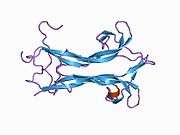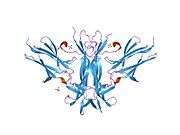Neurotrophin-4
Neurotrophin-4 (NT-4), also known as neurotrophin-5 (NT-5), is a protein that in humans is encoded by the NTF4 gene.[5] It is a neurotrophic factor that signals predominantly through the TrkB receptor tyrosine kinase.
References
- GRCh38: Ensembl release 89: ENSG00000225950 - Ensembl, May 2017
- GRCm38: Ensembl release 89: ENSMUSG00000074121 - Ensembl, May 2017
- "Human PubMed Reference:". National Center for Biotechnology Information, U.S. National Library of Medicine.
- "Mouse PubMed Reference:". National Center for Biotechnology Information, U.S. National Library of Medicine.
- "Entrez Gene: neurotrophin 4".
Further reading
- Childs AJ, Bayne RA, Murray AA, et al. (2010). "Differential expression and regulation by activin of the neurotrophins BDNF and NT4 during human and mouse ovarian development". Dev. Dyn. 239 (4): 1211–9. doi:10.1002/dvdy.22252. PMC 3410523. PMID 20175187.
- Vithana EN, Nongpiur ME, Venkataraman D, et al. (2010). "Identification of a novel mutation in the NTF4 gene that causes primary open-angle glaucoma in a Chinese population". Mol. Vis. 16: 1640–5. PMC 2927376. PMID 20806036.
- Truzzi F, Marconi A, Lotti R, et al. (2008). "Neurotrophins and their receptors stimulate melanoma cell proliferation and migration". J. Invest. Dermatol. 128 (8): 2031–40. doi:10.1038/jid.2008.21. PMID 18305571.
- Harel S, Jin S, Fisch B, et al. (2006). "Tyrosine kinase B receptor and its activated neurotrophins in ovaries from human fetuses and adults". Mol. Hum. Reprod. 12 (6): 357–65. doi:10.1093/molehr/gal033. PMID 16648150.
- Ribasés M, Hervás A, Ramos-Quiroga JA, et al. (2008). "Association study of 10 genes encoding neurotrophic factors and their receptors in adult and child attention-deficit/hyperactivity disorder". Biol. Psychiatry. 63 (10): 935–45. doi:10.1016/j.biopsych.2007.11.004. PMID 18179783.
- Chen ZY, Ieraci A, Teng H, et al. (2005). "Sortilin controls intracellular sorting of brain-derived neurotrophic factor to the regulated secretory pathway". J. Neurosci. 25 (26): 6156–66. doi:10.1523/JNEUROSCI.1017-05.2005. PMC 1201519. PMID 15987945.
- Pasutto F, Matsumoto T, Mardin CY, et al. (2009). "Heterozygous NTF4 mutations impairing neurotrophin-4 signaling in patients with primary open-angle glaucoma". Am. J. Hum. Genet. 85 (4): 447–56. doi:10.1016/j.ajhg.2009.08.016. PMC 2756554. PMID 19765683.
- Ibáñez CF (1996). "Neurotrophin-4: the odd one out in the neurotrophin family". Neurochem. Res. 21 (7): 787–93. doi:10.1007/BF02532301. PMID 8873083.
- Nalbandian A, Pang AL, Rennert OM, et al. (2005). "A novel function of differentiation revealed by cDNA microarray profiling of p75NTR-regulated gene expression". Differentiation. 73 (8): 385–96. doi:10.1111/j.1432-0436.2005.00040.x. PMID 16316409.
- Liu Y, Liu W, Crooks K, et al. (2010). "No evidence of association of heterozygous NTF4 mutations in patients with primary open-angle glaucoma". Am. J. Hum. Genet. 86 (3): 498–9, author reply 500. doi:10.1016/j.ajhg.2009.11.018. PMC 2833375. PMID 20215012.
- Götz R, Schartl M (1994). "The conservation of neurotrophic factors during vertebrate evolution". Comp Biochem Physiol Pharmacol Toxicol Endocrinol. 108 (1): 1–10. doi:10.1016/1367-8280(94)90082-5. PMID 8061955.
- Gratacòs M, EscaramÃs G, Bustamante M, et al. (2010). "Role of the neurotrophin network in eating disorders' subphenotypes: body mass index and age at onset of the disease". J Psychiatr Res. 44 (13): 834–40. doi:10.1016/j.jpsychires.2010.01.009. PMID 20219210.
- Chakrabarti B, Dudbridge F, Kent L, et al. (2009). "Genes related to sex steroids, neural growth, and social-emotional behavior are associated with autistic traits, empathy, and Asperger syndrome". Autism Research. 2 (3): 157–77. doi:10.1002/aur.80. PMID 19598235.
- Mizuno N, Shiba H, Inui T, et al. (2008). "Effect of neurotrophin-4/5 on bone/cementum-related protein expressions and DNA synthesis in cultures of human periodontal ligament cells". J. Periodontol. 79 (11): 2182–9. doi:10.1902/jop.2008.070402. PMID 18980528.
- Gerhard DS, Wagner L, Feingold EA, et al. (2004). "The status, quality, and expansion of the NIH full-length cDNA project: the Mammalian Gene Collection (MGC)". Genome Res. 14 (10B): 2121–7. doi:10.1101/gr.2596504. PMC 528928. PMID 15489334.
- Rao KN, Kaur I, Parikh RS, et al. (2010). "Variations in NTF4, VAV2, and VAV3 genes are not involved with primary open-angle and primary angle-closure glaucomas in an Indian population" (PDF). Invest. Ophthalmol. Vis. Sci. 51 (10): 4937–41. doi:10.1167/iovs.10-5553. PMID 20463313.
- Gratacòs M, Costas J, de Cid R, et al. (2009). "Identification of new putative susceptibility genes for several psychiatric disorders by association analysis of regulatory and non-synonymous SNPs of 306 genes involved in neurotransmission and neurodevelopment". Am. J. Med. Genet. B Neuropsychiatr. Genet. 150B (6): 808–16. doi:10.1002/ajmg.b.30902. PMID 19086053.
- Mercader JM; Saus E; Agüera Z; et al. (2008). "Association of NTRK3 and its interaction with NGF suggest an altered cross-regulation of the neurotrophin signaling pathway in eating disorders". Hum. Mol. Genet. 17 (9): 1234–44. doi:10.1093/hmg/ddn013. PMID 18203754.
- Walz JC; Magalhães PV; Giglio LM; et al. (2009). "Increased serum neurotrophin-4/5 levels in bipolar disorder". J Psychiatr Res. 43 (7): 721–3. doi:10.1016/j.jpsychires.2008.10.005. PMID 19081579.
- Prakash YS, Iyanoye A, Ay B, et al. (2006). "Neurotrophin effects on intracellular Ca2+ and force in airway smooth muscle". Am. J. Physiol. Lung Cell Mol. Physiol. 291 (3): L447–56. doi:10.1152/ajplung.00501.2005. PMID 16648236.
External links
- neurotrophin+4 at the US National Library of Medicine Medical Subject Headings (MeSH)
- neurotrophin+5 at the US National Library of Medicine Medical Subject Headings (MeSH)
This article is issued from Wikipedia. The text is licensed under Creative Commons - Attribution - Sharealike. Additional terms may apply for the media files.






